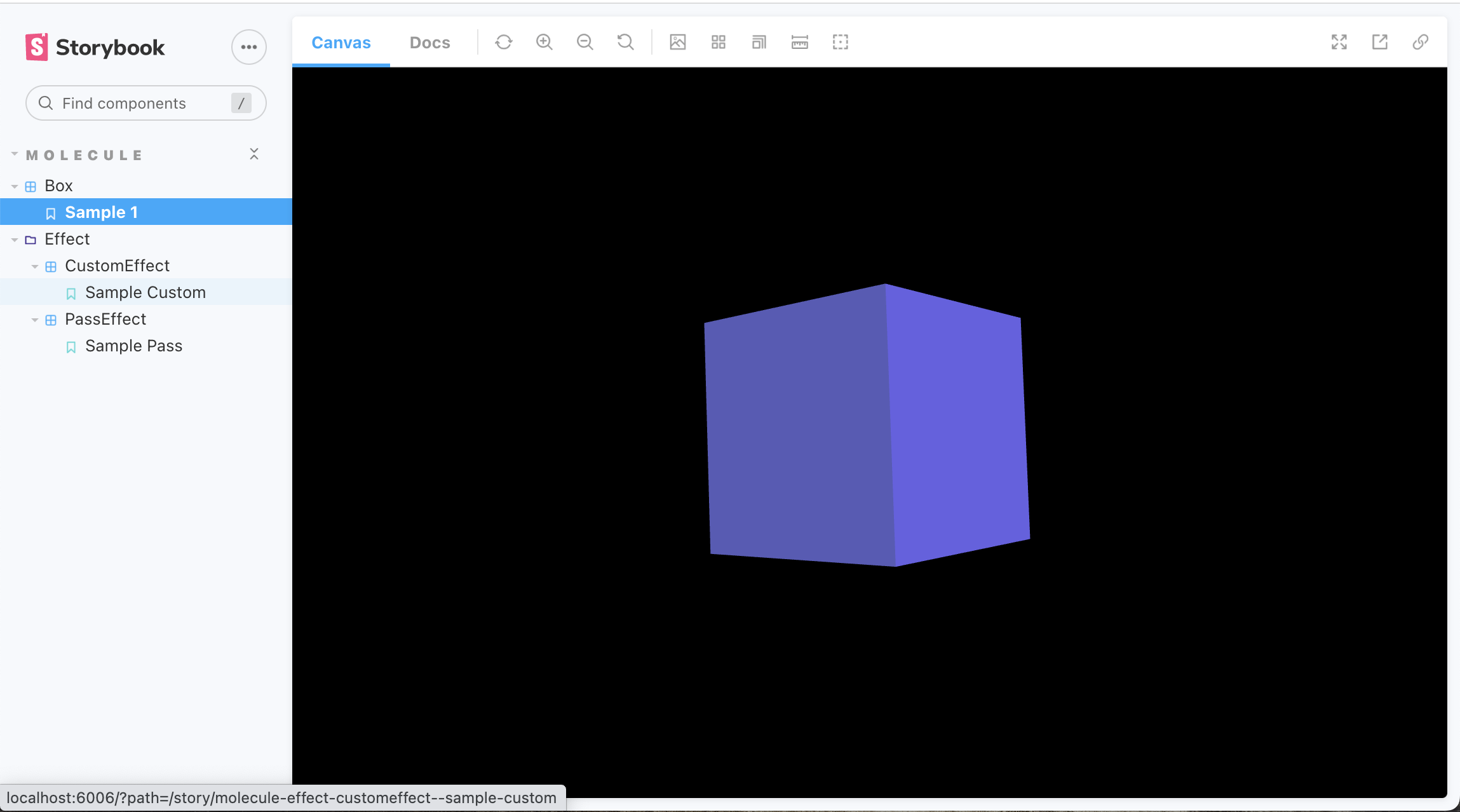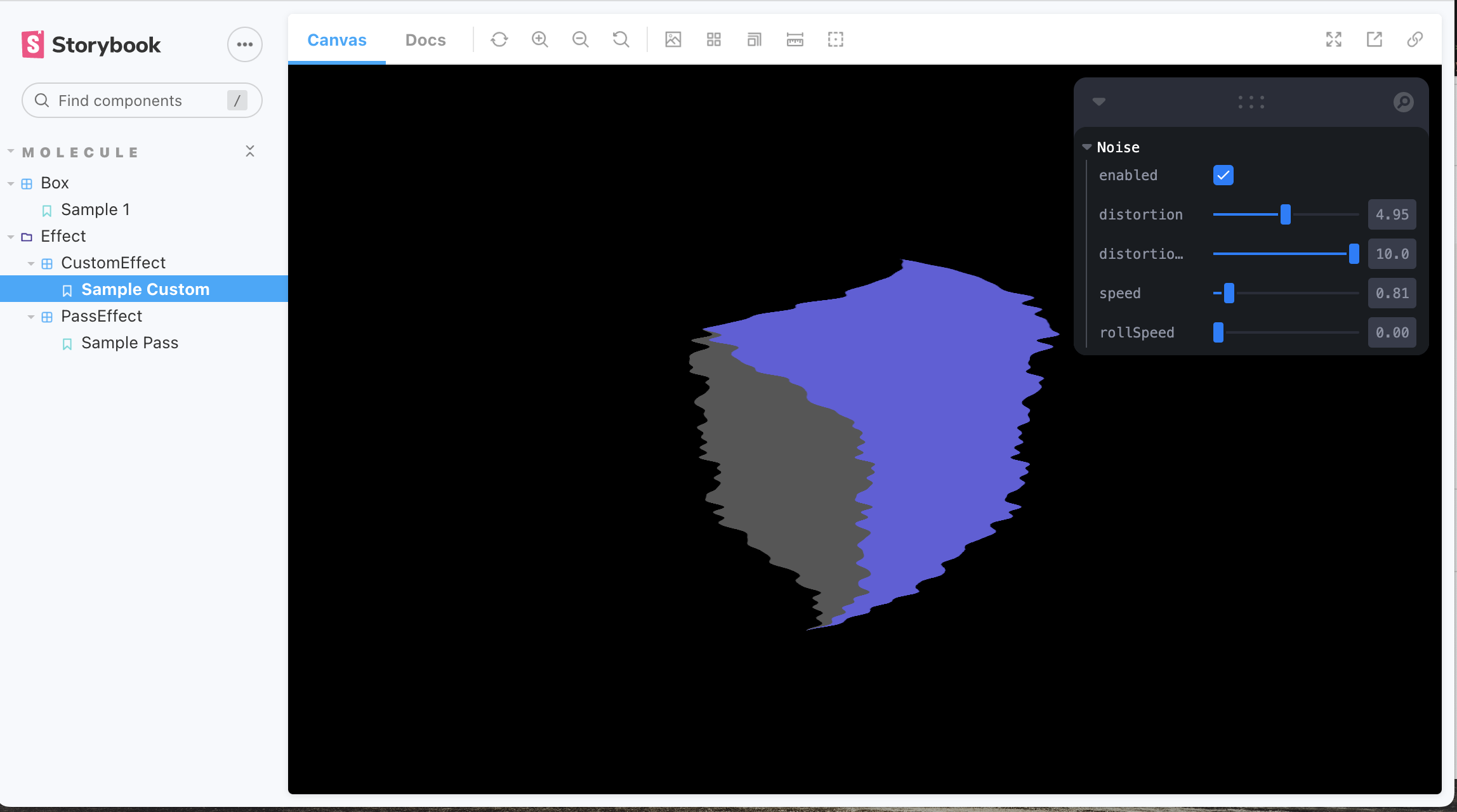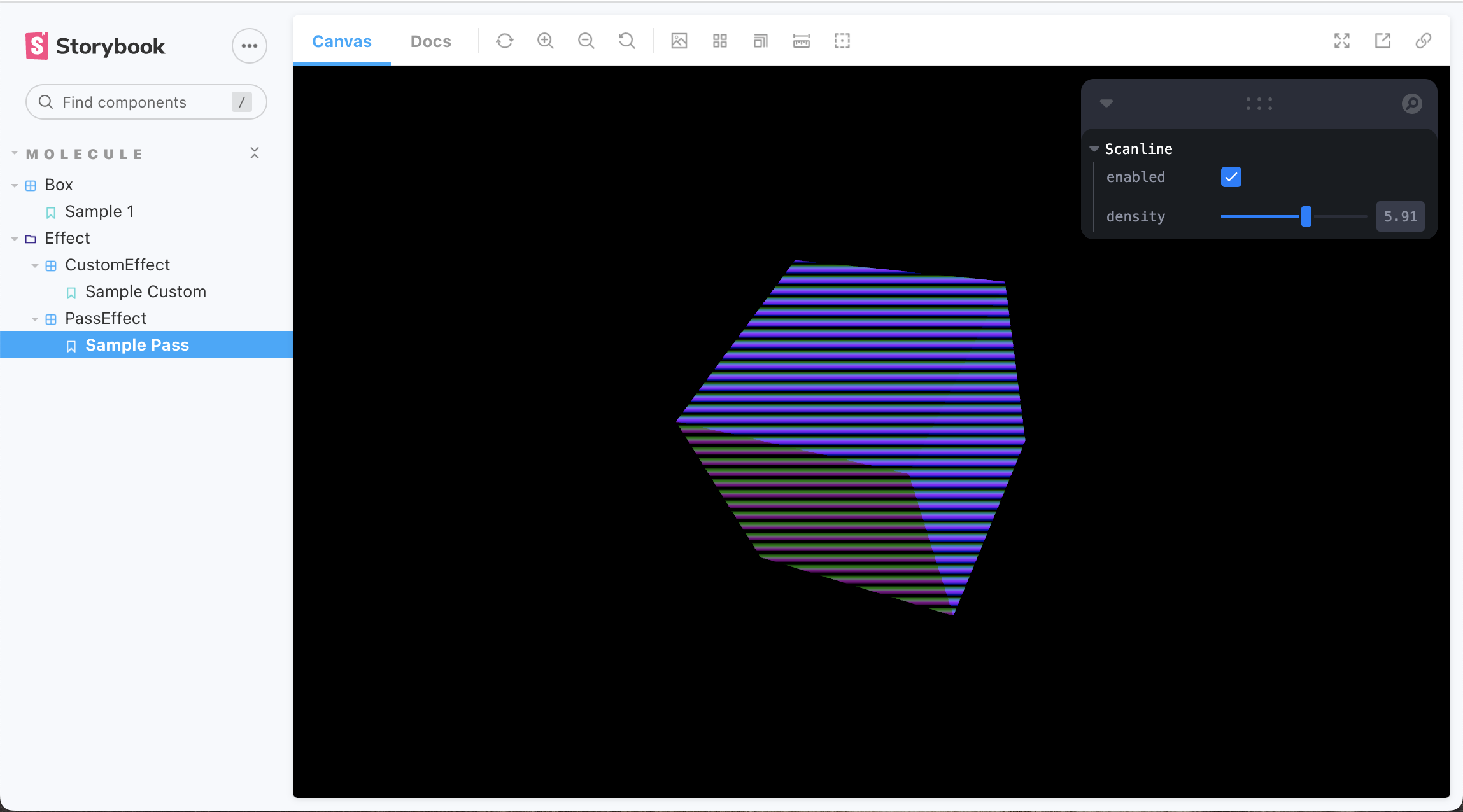1. 概要
前回、React Three Fiberにて作成した3DオブジェクトをStorybook上で管理する、環境構築に関する記事を書かせていただきました。
今回は、前回の環境を用い、Post-processingによるエフェクト処理をStorybook上で管理できる様に改修しましたので、ご共有します。
2. 内容
前回時点

今回はPost-processingにより、下図の様なEffectが掛かる所まで作成しました

React Three Fiberの素晴らしい所は、Post-processingの様なフィルター処理ですらもComponentとして宣言的に扱える事です
これにより、 React上にて、Functional Componentを柔軟に組み合わせることにより、様々なSceneの作成に柔軟に再利用することができます。
参考記事
- 【React Three Fiber】Post-processingにShaderを適用する
- Code Sandboxr3f + postprocessing CustomEffect R&D
- 驚くほど簡単に3Dシーンを構築!React Three Fiberを使ってみた
Storybookを除く、コード部分等は、1,2を参考とさせていただきました。
3. 技術
- レンダリング後のシーン全体にEffectを掛ける処理 =
Post-processingを、引き続きReact Three Fiberを用いて行いました。 - Effect処理を宣言できるComponentを、前回同様
Storybookにてカタログ管理できるようにしました。
コード全体は以下のgithub repositoryにて公開しています
StoryBookとは
Storybookは簡潔には、UIのカタログ作成ツールです。コンポーネントというUIのパーツ単位でデザイン、及び動作確認が可能です。
React Three Fiberとは
javascript上で、webglベースでの3D表現を行えるライブラリのデファクト的存在であるThree.jsに対し、従来の手続き的な書き方でなく、React的な宣言的な記述にて扱える様にしたwrapperライブラリです。
<Canvas>
<!-- lightの設定 -->
<ambientLight />
<!-- レンダリング対象のオブジェクトの設定 -->
<mesh>
<boxGeometry />
<meshStandardMaterial />
</mesh>
<!-- Effectの設定 -->
<EffectComposer>
</EffectComposer>
</Canvas>
今回は<EffectComposer>によるEffectの追加の話がメインです。
Post-processingとは
映像処理手法の一つであり、「画面に描画する直前に、後掛けのエフェクト(フィルター)を掛ける事」という認識です
詳しくは、Unity Documentation - Post Processingなどが参考になるかもしれません
有名どころとしては、BlurやGlitch等です
上のthumbnail画像の様な処理 (例: Glitch処理)をレンダリング結果に掛ける事を目的としています。
Post-processingの作成に必要なライブラリ
以下のライブラリをinstallする必要があります
1. Three.jsに予め組み込まれたものを使用する場合
$ yarn add @react-three/postprocessing
2. 自分で作成したShader (Custom Shader)を使用する場合
$ yarn add @react-three/postprocessing postprocessing
postprocessing内のEffectクラスを継承して使用する必要があります。
実装
1. Three.jsに組み込まれたShaderを使用する場合
src
L components/molecules/Effect
L PassEffect
L index.tsx
L index.stories.tsx
import { EffectComposer, Scanline } from '@react-three/postprocessing';
type Props = {
density?: number;
};
const PassEffect: React.FC<Props> = ({ density = 0.1 }) => {
return (
<EffectComposer>
<Scanline density={density} />
</EffectComposer>
);
};
export default PassEffect;
@react-three/postprocessingから必要なEffect用のComponentをimportしてEffectComposerのchildrenとして渡してあげるだけでシンプルに実現できます。
const Template: ComponentStory<typeof PassEffect> = () => {
const datas = useControls('Scanline', {
enabled: true,
density: { value: 1.25, min: 0, max: 10, step: 0.01 },
});
return (
<>
<DemoScene cameraPosition={[2, 2, 2]}>
<directionalLight color="blue" position={[3, 3, 0]}></directionalLight>
<Box position={[0, 0, 0]} />
{datas.enabled ? <PassEffect density={datas.density} /> : <></>}
</DemoScene>
</>
);
};
Storybook側 (*.stories.tsxファイル)からは上記の様に呼び出します。
尚、useControlsはlevaに含まれます。下図右上の様なコントローラを表示してくれます。
結果
2. Custom Shaderを使用する場合
src
L components/molecules/Effect
L CustomEffect
L index.tsx
L index.stories.tsx
L utils/shader
L TVNoise
L index.ts // shaderとcomponent間のIFを扱う
L fragment.ts // フラグメントシェーダ (postprocessing)
呼び出し元から順に追っていくと・・・
const Template: ComponentStory<typeof CustomEffect> = () => {
... // datasにはleva: useControlsの返り値が格納されている
return (
<>
<DemoScene cameraPosition={[2, 2, 2]}>
<directionalLight color="blue" position={[3, 3, 0]}></directionalLight>
<Box position={[0, 0, 0]} />
{datas.enabled ? (
<CustomEffect
distortion={datas.distortion}
distortion2={datas.distortion2}
speed={datas.speed}
rollSpeed={datas.rollSpeed}
/>
) : (
<></>
)}
</DemoScene>
</>
);
};
CustomEffectが自作したEffect Componentです。
それぞれ引数を渡しています
import { Effect } from 'postprocessing';
import { TVNoiseShader } from '../../../../utils/shader/TVNoise';
class MyCustomEffectImpl extends Effect {
constructor(props: EffectProps) {
const shader = TVNoiseShader({ ...props });
super('MyCustomEffect', shader.fragmentShader, {
uniforms: shader.uniforms,
});
}
}
...
const CustomEffect = forwardRef<unknown, Props>((props, ref) => {
const effect = useMemo(
() =>
new MyCustomEffectImpl({
distortion: props.distortion,
distortion2: props.distortion2,
speed: props.speed,
rollSpeed: props.rollSpeed,
}),
[props?.distortion, props?.distortion2, props?.speed, props?.rollSpeed]
);
return (
<EffectComposer>
<primitive ref={ref} object={effect} dispose={null} />
</EffectComposer>
);
});
export default CustomEffect;
尚、Shaderは参考資料2におけるShaderを参考にしています。
import { Uniform } from 'three';
import { fragmentShader } from './fragment';
...
export const TVNoiseShader = ({
distortion = 3.0,
distortion2 = 6.0,
speed = 0.5,
rollSpeed = 0.2,
}: EffectProps) => ({
uniforms: new Map([
['texture', new Uniform(null)],
['distortion', new Uniform(distortion)],
['distortion2', new Uniform(distortion2)],
['speed', new Uniform(speed)],
['rollSpeed', new Uniform(rollSpeed)],
]),
fragmentShader,
});
export const fragmentShader = /* glsl */ `
// ... 略
void mainUv(inout vec2 uv) {
uv = vec2(...); // 略
}
`;
fragmentShaderに関してはtemplate literal (文字列形式)で記載しました。
結果
以下の様に、古いTVのNoiseの様な歪みがPost-processingにて表現される事が確認できました。

総括
コード全体は以下のgithub repositoryにて公開しています
自作したエフェクトをStorybookにてカタログ管理できるのは、とても便利に感じました。
今迄作り溜めていたコードを、どんどんまとめていきたいと思いました。
一方で、Storybook自体の機能をいまいち使いこなしていない気もするので
今後は、Storybookの魅力にフォーカスした記事の作成も検討してみたいと思います。
引き続き、どうぞよろしくお願い致します。
以上
